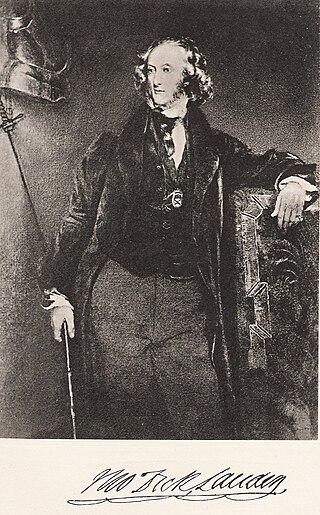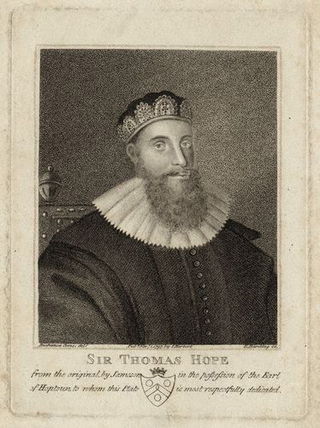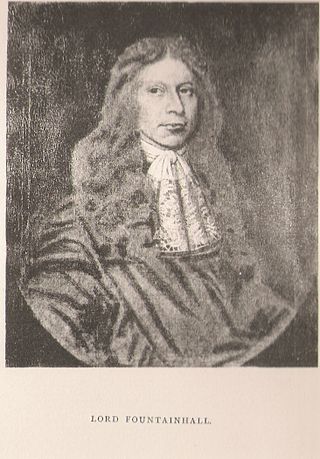Related Research Articles

Earl of Galloway is a title in the Peerage of Scotland. It was created in 1623 for Alexander Stewart, 1st Lord Garlies, with remainder to his heirs male bearing the name and arms of Stewart. He had already been created Lord Garlies in the Peerage of Scotland in 1607, with remainder to the heirs male of his body succeeding to the estates of Garlies. This branch of the Stewart family were distant relatives of the Stewart Kings of Scotland.

Sir Thomas Dick Lauder of Fountainhall, 7th Baronet, FRSE FSA(Scot) LLD was a Scottish author. He served as Secretary to the Board of Manufactures (1839–), on the Herring Fisheries Board, at the Royal Institution for the Encouragement of the Fine Arts, and as Deputy Lieutenant of both counties of Moray and Haddington.

Sir Thomas Hope, 1st Baronet Hope of Craighall (1573–1646) was a Scottish lawyer, and Lord Advocate under Charles I.
There has been one baronetcy granted to the Lauder family. The baronetcy of Lauder of Fountainhall, Haddingtonshire, was created for John Lauder, last surviving male representative of the Lauders of that Ilk, a rich merchant-burgess and sometime Treasurer and baillie of the City of Edinburgh Council, and an armiger. He purchased the estate of Newington, Edinburgh, and subsequently the lands of Woodhead and Templehall near Pencaitland, which along with others in Edinburghshire and Haddingtonshire, were erected by Crown charter into the feudal barony of Fountainhall on 13 August 1681.

Sir John Lauder, 1st Baronet, of Newington and Fountainhall was a notable Scottish baillie and Treasurer of the City of Edinburgh Council, who was raised to a Nova Scotia baronetcy in 1688.
Sir Andrew Lauder of Fountainhall, 5th Baronet was a Burgess of the Royal Burgh of Lauder, and also of Musselburgh.
Sir Thomas North Dick Lauder of Fountainhall, 9th Baronet KStJ was a Scottish aristocrat and a Knight of Justice in the Order of St. John of Jerusalem

Sir George William Dalrymple Dick Lauder of Fountainhall, 10th Baronet was an Indian Civil Service Senior Administrator in the Government of India's Opium Department.
Sir Alexander Lauder of Fountainhall, 4th Baronet succeeded to the baronetcy of his father, Sir John Lauder, 3rd Baronet in February 1728. He was made an Honorary Burgess of the City of Glasgow on 16 September of that year, and of the burgh of Aberdeen on 15 August 1729. He died unmarried and was interred in the Lauder burial vault within Greyfriars Kirk.

Sir John Lauder of Fountainhall, 2nd Baronet, Lord Fountainhall was one of Scotland's leading jurists who remains an oft-consulted authority. He was knighted in 1680 and matriculated his Arms with the Lyon Court on 15 June 1699.
Sir Thomas Burnett of Leys, 3rd Baronet,, Lord Clerk Register, PC, MP. He was, at Stonehaven, 21 April 1664, retoured as heir to his father, Sir Alexander Burnett, 2nd Baronet who had died the previous year. The 3rd Baronet is the grandson of Sir Thomas Burnett, 1st Baronet, who completed the reconstruction of Muchalls Castle and the great-grandson of Alexander Burnett of Leys, who completed the construction of Crathes Castle.

Sir Andrew Ramsay, Lord Abbotshall, Privy Counsellor, was the first Lord Provost of Edinburgh and a judge of the Court of Session.
Sir Alexander Seton of Pitmedden, 1st Baronet, Lord Pitmedden was a Scottish advocate, a Senator of the College of Justice, a Lord of Justiciary, and a Commissioner.
Sir George Lauder of the Bass, Knight, was a cleric, Privy Counsellor, and Member of the Scottish Parliament. He was a legal tutor to Prince Henry.
Sir John Home of Renton, Lord Renton was appointed Lord Justice Clerk by King Charles II. He was also a Senator of the College of Justice with the title Lord Renton.
The Broun Baronets are a branch of the ancient Broun of Colstoun family whose estate near Haddington, East Lothian, remains to this day in the possession of a cadet family.

Sir Robert Lauder of Beilmouth, Knt., was an armiger, lawyer and Clerk of Exchequer in Scotland. In 1683 he was made a Justice of the Peace for Haddingtonshire. As Robert Lauder of Belhaven he was in the old Scottish parliament for Haddington in 1685, and, as Sir Robert Lauder of Beilmouth, in 1704. He was also Commissioner of Supply for Haddington in 1689 and 1690.

Greyfriars Kirkyard is the graveyard surrounding Greyfriars Kirk in Edinburgh, Scotland. It is located at the southern edge of the Old Town, adjacent to George Heriot's School. Burials have been taking place since the late 16th century, and a number of notable Edinburgh residents are interred at Greyfriars. The Kirkyard is operated by City of Edinburgh Council in liaison with a charitable trust, which is linked to but separate from the church. The Kirkyard and its monuments are protected as a category A listed building.

George Scot or Scott of Pitlochie, Fife was a Scottish writer on colonisation in North America.

Sir Hugh Campbell of Cessnock in Ayrshire was a 17th-century baronet of Cessnock. His lineage was from the Campbells of Loudoun.
References
- Sir Robert Douglas; et al. (1798). The Baronage of Scotland. Edinburgh. p. 184.
- James Brown (1864). Monumental Inscriptions in Greyfriars Churchyard. Edinburgh. pp. 301–302.
{{cite book}}: CS1 maint: location missing publisher (link), has the burial vault within the church of the family of Lauder of Lauder, and all who are contained therein. - G. E. Cokayne (1904). The Complete Baronetage. Exeter. p. 361.
{{cite book}}: CS1 maint: location missing publisher (link)